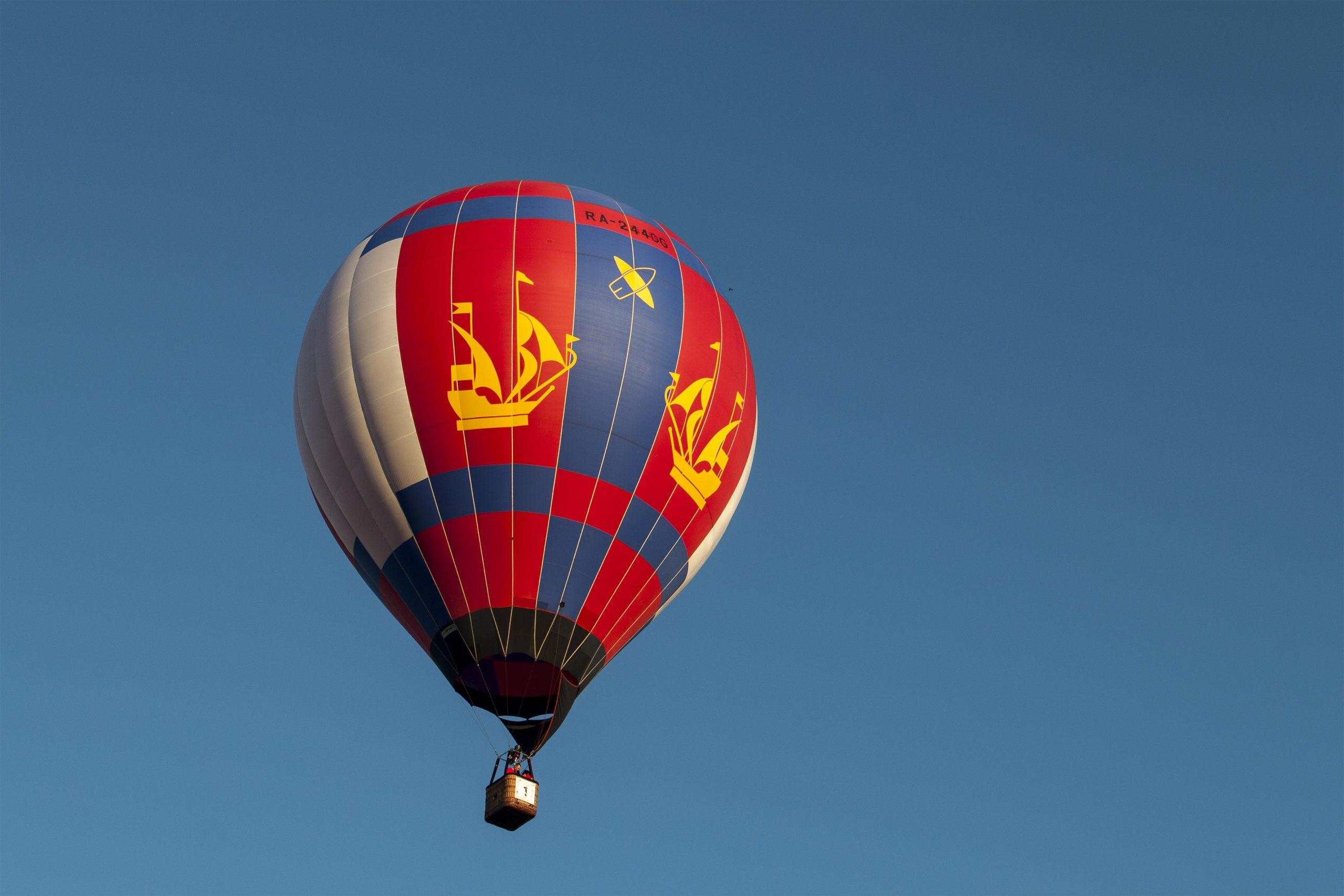
flying balloons
The first documented attempt to lift a balloon into the air was made in 1709 by Bartolomeo Lourenço de Gusmão. On June 5, 1783, the brothers Joseph Michel and Jacques-Étienne Montgolfier made the first successful attempt at Annonay to lift a paper-canvas balloon Ad Astra (To the Stars) filled with hot air. The balloon flew 2336 m, rising to a height of about 1,8 km. What a balloon flight looks like today, you will learn from the following article.
280-220 tenge There are hot testimonies of military signals in China during the Three Kingdoms era. These were air lanterns called kunming, which were subsequently used many times, incl. Mongols at the Battle of Legnica. There is no direct evidence that the Chinese made a crewed balloon flight, but there are indications that it may have occurred.
1. Balloon model by Bartolomeo Laurenso de Gusmao.
1709 The first documented attempt with a model similar in principle to the hot air balloon known today was made by the court chaplain of the Portuguese king John V - Bartolomeo Lorenzo de Gusman (1).
1782-83 The first paper and fabric balloon filled with hot air was launched in December 1782 at Annona by two French brothers: Joseph Michel i Etienne Jacques Montgolfier (2). Their balloon with a diameter of about twelve meters, called Ad Astra (to the stars) he flew almost 2,5 km, taking off to a height of about 1,8 km.
The ball, made by the Montgolfier brothers, had a hole at the bottom, under which a fire was lit, burning in a fire arranged in a boat-shaped container attached to the ball. A few months later, the brothers repeated a successful attempt to escape in the presence of King Louis XVI, the court and many eminent spectators. Attached to the balloon was a cage containing a duck, a rooster and a ram. The spectacle lasted only a few minutes, as the balloon's shell ruptured and it naturally fell, but gently so that no one was hurt.
November 21, 1783 physicist Jean Francois Pilatre de Rozier he became the first person in the world to rise 1785 meters above the ground in a hot air balloon Montgolfier. At 15, he became the first victim of a plane crash. While trying to fly over the English Channel, a hybrid balloon filled with air and hydrogen caught fire 500 minutes after takeoff and fell from a height of XNUMX meters.
2. Hot air balloon Montgolfier
1783 Building on work Robert Boylea, Henry'his Cavendish i Tiberiusha Mare Frenchman Jacques Charles designed a balloon filled with hydrogen and launched it on August 27, 1783 in Paris. Balloon fell outside the city, where the population, believing that they were dealing with some kind of infernal dragon, tore it into small pieces. Initially, this type of balloon was called (English charlter), and the balloon was called a hot air balloon. In December 1783, he himself flew on a hydrogen balloon, the cover of which was made of rubberized fabric with a grid on which a basket was hung; in the case there was a hatch for releasing gases from it during the flight. It was also fitted with a ballast and a barometer used to measure the altitude of the climb.
1785 Jean-Pierre Blanchard.
1794 The army of the French Republic uses tethered observation balloons, which contributed to the victory at Fleurus, making it easier to track the movements of enemy troops.
1797 In Paris, a 700-meter balloon flies over the Parc Monceau, after which the balloonist makes the first ever skydiving from a gondola.
1836 First long-distance balloon flight. Large Nassau balloon (2407 cubic meters) piloted by a British balloonist. Charles Green flies 800 km from London to Weilburg in Germany in 18 hours (3).
1852 balloons were looking for ways to control the direction of the flight of the balloon and navigate efficiently. The first controllable balloon (later called an airship) was launched by Henry Giffard in 1852. He flew about 27,5 km from Paris to Elancourt at a speed of about 8 km/h. In 1855, Giffard designed another airship model, which, however, crashed.
1870 Balloons used for military surveillance during the Franco-Prussian War. During it, one of the French ministers made a dramatic balloon escape from besieged Paris.
1872 Paul Henlein used a (tethered) 5 hp Lenoir four-cylinder engine. at 40 rpm.
4. Flight of the airship Albert Santos-Dumont in 1901.
1898-1901 First at ease flying airship it was powered by an Alberto Santos-Dumont internal combustion engine. However, the first building was not very successful. Success brought Santos-Dumont airship number 6 built in 1901, took off from the park at Saint-Cloud on October 19, 1901, rounded the Eiffel Tower (4) and returned in less than half an hour. This flight brought him great fame and the Deutsche de la Meurthe Prize in the amount of 100 1903 francs, half of which he gave to help the poor. Since XNUMX, Santos-Dumont has operated commercial flights of its airships over Paris from Neuilly Air Base.
1900 Count Ferdinand von Zeppelin, a German general, aeronautical engineer and designer, builds the first successful airship frame for a 12-hour flight between Switzerland and Bavaria.
From 1910 to 1914 Zeppelin airships passed accident-free passenger transportation for a length of about 160 km, and since 000 they were included in the army equipment. Airships, popularly called "zeppelins" in honor of their designer, made during the First World War (1913) bombing raids, incl. to Antwerp, Liege, Warsaw, Paris, London, Naples, Humberside, East Anglia, Tyneside and made reconnaissance flights.
5. The use of balloons during the First World War
1914 Balloon Berliner flies 3052 km from Bitterfield in Germany to Perm in Russia.
1931 Auguste Antoine Piccard, a Swiss researcher, developed the basic assumptions about the structure in the early 30s. bathyscaphebut not implemented at the time. Based on these assumptions, he built in 1930. stratostat (6). In honor of the main sponsor, the Belgian National Research Foundation, the balloon was named "FNRS". On May 27, 1931, Picard, together with Paul Kipfer from Augsburg, climbed to a record height of 15 meters, making many important measurements of the atmosphere and cosmic rays during the flight. Professor Picard made another 785 flights into the stratosphere, reaching a maximum altitude of 26 meters.
1937 When mooring at Lakehurst Airport in New Jersey in the USA, the airship LZ 129 "Hindenburg" (7) exploded, after which the use of this type of aircraft was abandoned. German passenger airship, the largest in history (along with the twin LZ-130 Graf Zeppelin II), had a length of 245 m and a diameter of 41 m; it contained 200 m³ of hydrogen in 000 tanks. It was equipped with four 16 hp diesel engines. every. The maximum speed reached 1200 km / h. The Hindenburg could carry 135 passengers (72 on a transatlantic cruise) and 50 crew members.
7. Hindenburg airship crash
1940-45 During World War II, the British used balloons to protect London from bombing raids. They were not always effective because, for example, the German Heinkel He 111 bombers had too high an altitude to be feared. However, some V-1 rockets were destroyed thanks to these protective balloons.
60-ies Resurgence in the popularity of hot air balloons. This happened after air was first used for heating. propane burners.
1961 American Malcolm D. Ross with navigator Victor A. Prater aboard the Lee Levis Memorial balloon rises to a height of 34 meters. The balloon took off from the USS Antietam in the Gulf of Mexico. This is the absolute altitude record for a balloon flight with a person to date.
1978-2015 The last decades have been a time of impressive ballooning records. In 1978, Ben Abruzzo, Maxi Anderson and Larry Newman in the Double Eagle II balloon broke the record for the longest flight of a helium-filled structure, flying continuously for 137 hours 5 minutes 50 seconds. In turn, the distance record - 8383 km - since 1981 in the crew of "Double Eagle V" 4 people. They were Ben Abruzzo, Larry Newman, Ron Clark and Rocky Aoki.
In early 2015, American Troy Bradley and Russian Leonid Tyukhtyaev broke both old world records for range and duration of flight on a gas cylinder. Their balloon "Two Eagles" filled with helium was launched from Saga Prefecture in Japan. They flew over the Pacific Ocean for 6 days 16 hours 37 minutes (160 hours 37 minutes) and during this time covered 10 km, 696 km from the coast of Mexico.
1987 First transatlantic balloon flight. Richard Branson and Per Linstrand fly over the Atlantic in the Virgin Atlantic Flyer, the world's largest balloon at 65129 24640 cubic meters. The balloon travels 33 km in a record time of 209 hours and reaches speeds of over 10720 km/h. Four years later, the same crew flies XNUMX, XNUMX km in a hot air balloon over the Pacific Ocean.
1999 Bertrand Picard (Switzerland) as a pilot and Brian Jones (Great Britain), navigator, while flying around the Earth in a balloon "Breitling Orbiter" broke distance records without landing - 40814 477 km, flight duration - 47 hours 370 minutes, and the speed of the Earth in orbit – 24 hours XNUMX minutes.
2002 Steve Fossett was the first to circumnavigate the globe in a solitary balloon flight (8). Prior to that, in 1995, he was the first person to fly solo over the Pacific in a hot air balloon. She departed Northam, Western Australia on 19 June 2002 to return to the continent and landed in Queensland on 3 July 2002. He was in the air for 14 days. His balloon was moving at a speed of about 250 km/h. This was Fossett's sixth attempt to fly solo around the Earth.
2005 Vijaypat Singhania sets altitude record balloon flight, taking off at 21 m in a huge balloon with a height of more than 290 meters, equipped with a pressurized pressurized cabin.
Balloon types
Gas cylinders
W gas cylinders Lighter-than-air gases such as helium and hydrogen are used. Sometimes gas heating is used. The cover of the gas cylinder is made of fabric with a rubber coating (cotton, silk or synthetic fabrics). It is braided with mesh, the ends of which are attached to the support rim - a basket is suspended from the rim. The so-called navigation flapto release gas. The flight altitude increases after the ballast is dropped. Its function is performed by sand and water bags attached to the rim of the cylinder. Flight descent obtained by venting gas through a damper. Such balloons are expensive to handle.
Balloons
The hot air balloon consists of a gondola (basket) in which the crew sits, the burner and the body in the shape of a ball or other shape (today you can find very bizarre designs). Paper was used for the first balloons of this type, which was quite dangerous.
Today, very durable and non-flammable polyester fabrics are used. Nomex, a fabric developed by NASA for spaceflight, is used for the critical underside of the shell that protects the flame from the heating burner. However, the basket is still mostly made from vines. The flight altitude is regulated by heating the air inside the body with burners, the power of which reaches up to 2500 kW! They run on propane from large tanks (even 80 liters) with a durable design. The burners consume about 30 kg of propane per flight hour. Cold air blowers are used to fill the envelope before takeoff (to save gas and protect the balloon envelope from fire), and the envelope is filled with warm air just before takeoff.
Airships
Balloons lighter than air are equipped with a propulsion system and a control system. Airships are divided into:
- skeleton - with a body frame, previously made of wood, today made of duralumin, coated with a special coating, coated on the outside with substances that provide high surface smoothness and resistance to solar radiation and moisture.
- Half skeleton - intermediate solutions between the frame and the pressure airship. They are distinguished by the use of a truss located along the lower part of the hull, which stiffens the airship, reducing its susceptibility to deformation in flight, as is the case with pressure helmet airships.
- Pressure - varieties of airships, the shell of which retains its shape due to the excess pressure of the carrier gas. The volume of the carrier gas changes with temperature and flight altitude, which changes the shape of the shell. Air pressure can also have a similar effect. To prevent this from happening, pressure airships use cylinders, the volume of which can be changed if necessary by forcing air into them using superchargers or sometimes by the dynamic pressure of a helical jet. Thus, the external shape of the airship does not change.
Depending on the flight technique and application, the following categories of balloons are also distinguished:
- free balloons - not at anchor, moving with the wind, including:
- meteozone,
- stratostats;
- tied balloonswhich includes:
– observation balloons,
- barrier balls
- for the training of paratroopers,
- Surveillance balloons.

